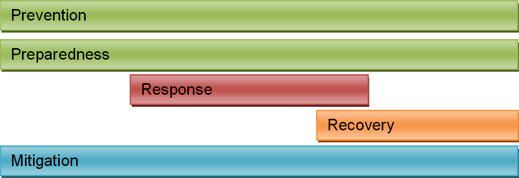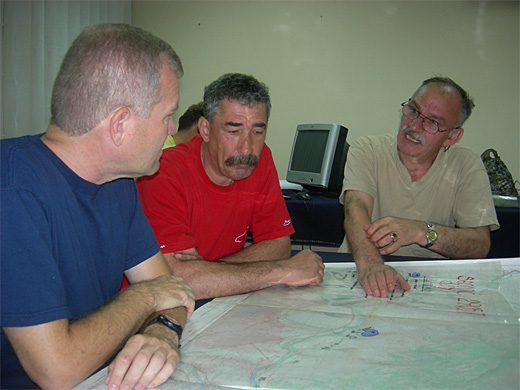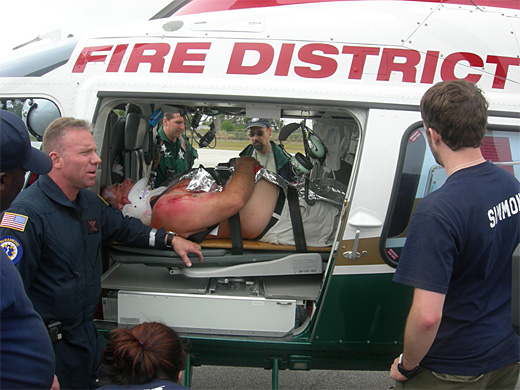Emergency Management
This portion of the lesson is the summary of FEMA online course IS-230 Principles of Emergency Management. If you want to know more, I encourage you to take the full course online. Anyone working or wishing to work in this area needs this training. Take the course, complete the final examination, and send me your certificate and I will award 50 points of extra credit.
Integrated Emergency Management System
When an emergency or disaster occurs:
- Agencies from different jurisdictions and government levels need to work together. Major emergencies and disasters ignore city, county, and state boundaries.
- Rapid decision making is required.
Without planning and coordination, emergency operations can suffer from serious misdirection and mistakes.
An integrated emergency management system provides a conceptual framework for organizing and managing emergency protection efforts. This framework prescribes when and how local officials and agencies will work together to deal with a full range of emergencies, from natural disasters to terrorism.
Each level of government participates in and contributes to emergency management.
- Local government has direct responsibility for the safety of its citizens, knowledge of the situation and personnel, and proximity to both the event and resources. Emergency Support Services are the departments of local government that are capable of responding to emergencies 24 hours a day. They include law enforcement, fire/rescue, and public works. They may also be referred to as emergency response personnel or first responders.
- State government has legal authorities for emergency response and recovery and serves as the point of contact between local and Federal governments.
- Federal government has legal authorities; fiscal resources; research capabilities, technical information and services, and specialized personnel to assist local and State agencies in responding to and recovering from emergencies or disasters.
The Spectrum of Incident Management Actions
The NRP addresses threats and incidents by coordinating:
- Pre-incident activities, such as information sharing, threat identification, planning, and readiness exercises.
- Incident activities that include lifesaving missions and critical infrastructure support protections.
- Post-incident activities that help people and communities recover and rebuild for a safer future.


The NRP addresses the full spectrum of emergency management activities, including:
- Prevention:
Actions taken to avoid an incident or to intervene to stop an incident from occurring, actions taken to protect lives and property, and applying intelligence and other information to a range of activities that may include countermeasures.
- Preparedness:
The range of deliberate, critical tasks and activities necessary to build, sustain, and improve the operational capability to prevent, protect against, respond to, and recover from domestic incidents. Preparedness is a continuous process involving efforts at all levels of government and between government and private-sector and nongovernmental organizations to identify threats, determine vulnerabilities, and identify required resources.
- Response:
The activities that address the short-term, direct effects of an incident. Response also includes the execution of EOPs and of incident mitigation activities designed to limit the loss of life, personal injury, property damage, and unfavorable outcomes.
- Recovery:
The development, coordination, and execution of service- and site-restoration plans for impacted communities and the reconstitution of government operations and services through individual, private-sector, nongovernmental, and public assistance programs.
- Mitigation:
Activities that are designed to reduce or eliminate risks to persons or property, or lessen the actual or potential effects or consequences of an incident.
The Plan as Program Centerpiece
Between emergencies and disasters, emergency managers can focus on mitigation and preparedness measures. Hazard analysis is a crucial first step.
Hazard analysis determines
- What can occur.
- How likely it is to occur.
- The devastation it is likely to cause.
- How likely it is to affect the community.
- How vulnerable the community is to a hazard.
The first step is to develop a list of hazards that may occur in the community.
Next, hazard profiles should address each hazard's:
- Duration
- Seasonal pattern
- Speed of onset
The availability of Warnings also will play a crucial role in a hazard profile.
Hazard-specific information is combined with a profile of your community to determine the community's vulnerability—or risk of damage—from the hazard.
After information about the community is gathered, emergency managers use it to develop the community's hazard analysis. After a hazard and community profile has been compiled, it is helpful to quantify the community's risk by merging the information so that the community can focus on the hazards that present the highest risk.
Risk is the predicted impact that a hazard would have on people, services, and specific facilities and structures in the community. A severity rating quantifies the expected impact of a specific hazard.
Planning and Coordination

Figure 07.01: Dr. Paul Forage and Macedonian planners consult on the development of a simulated Emergency Operations Plan for the fictional country of Atlantica during Exercise Svetlina 2007 as part of the International Institute for Disaster Preparedness and International Humanitarian Aid.
SOURCE: Instructor photo.
An Emergency Operations Plan (EOP) is a key component of an emergency program.
When an emergency threatens or strikes, the community must be prepared to take immediate action. An EOP describes:
- What emergency response actions will occur….
- Under what circumstances….
- Using what resources….
- Who will be involved and by what authority.
An EOP consists of the following basic components:
- The Basic Plan
- Annexes
- Appendices
- Standard Operating Procedures
The EOP provides overall authority, roles, and functions during emergencies.
An Emergency Operation Center (EOC) is a central location where agency representatives can coordinate and make decisions when managing an emergency response. EOC personnel do not control the on-scene response but help on-scene personnel by establishing priorities, coordinating the acquisition and assignment of resources, and acting as a liaison with other communities and the State. The EOC is a place for working together.
The Multi-Agency Coordination System integrates facilities, equipment, personnel, procedures and communications into a common system with responsibility for coordinating and supporting domestic incident management activities. The functions of the system are to support incident management polities and procedures, facilitate logistical support and resource tracking, inform resource allocation decisions, coordinate incident-related information, and coordinate interagency and intergovernmental issues regarding policies, priorities, and strategies."
The Incident Command System (ICS) defines the operating characteristics, interactive management components, and structure of incident management and emergency response organizations engaged throughout the life cycle of an incident. NIMS requires the use of ICS.
Conclusion of mutual aid agreements to augment local resources is an important part of developing and maintaining an emergency management program.
In any emergency or disaster, mutual aid partners may be able to provide:
- Communications capability.
- Emergency personnel.
- Overall management strategy and program management.
- Equipment such as bulldozers or dump trucks.
- Sandbags.
- Facilities such as warehouses or temporary shelters.
The best way to communicate the plan to response agencies that are responsible for implementing the plan is through training and exercising.
Training is critical to response personnel so that they know:
- What they are to do.
- When they are do it.
- How they are to do it.

Figure 07.02: Port Saint Lucie County, Florida aerial evacuation helicopter crew conducting training with Exercise Atlantic Hope participants in March 2007. The pilot is a Sheriff's Deputy while the paramedic belongs to the fire department.
SOURCE: Instructor photo.
Functions of an Emergency Management Program
There are two ways to categorize emergency management activities:
- Emergency management core functions that are performed during an emergency.
- Emergency management program functions that continue on a day-to-day basis.
The eight emergency management core functions performed during emergencies are:
- Direction and Control
- Communications
- Warning
- Emergency Public Information
- Evacuation (or in-place sheltering)
- Mass Care
- Health and Medical
- Resource Management
Day-to-day emergency management program functions include:
- Hazard Identification and Risk Assessment
- Hazard Mitigation
- Resource Management
- Planning
- Direction and Control
- Communication and Warning
- Operations and Procedures
- Logistics and Facilities
- Training
- Exercises, Evaluations, and Corrective Actions
- Public Education and Information
- Finance and Administration
Emergency Management Program Partners
Emergency management partners include local, State, and Federal emergency managers.
The State's role is to supplement and facilitate local efforts before, during, and after emergencies. The State must be prepared to maintain or accelerate services and to provide new services to local governments when local capabilities fall short of disaster demands.
The local Emergency Program Manager has the day-to-day responsibility of managing emergency programs and activities. The role entails coordinating all aspects of a jurisdiction's mitigation, preparedness, response, and recovery capabilities.
The State provides direct guidance and assistance to local jurisdictions through program development, and it channels Federal guidance and assistance down to the local level. In a disaster the State office helps coordinate and integrate resources and apply them to local needs. The State's role might be best described as "pivotal."
The Federal government provides legislation, Executive Orders, and regulations that influence all disaster activities. It also maintains the largest pool of fiscal resources that can be applied to emergency management. Assistance may take the form of fiscal support, technical assistance, and information about materials, personnel resources, and research. FEMA takes a lead role in national preparedness for major crises. It also plays coordinating and supportive/assistance roles for integrated emergency management in partnership with State and local emergency management entities.